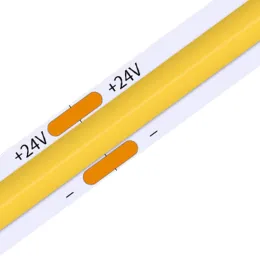The difference between high-voltage and low-voltage light strips
LED light strips are often used to outline the contours of various buildings. According to the differences in the use occasions of LED light strips and the different requirements for light strips, they are divided into three types: monochrome/colorful/magic light strips. There are two types of high-voltage LED light strips and low-voltage LED light strips. High-voltage LED light strips are also called AC light strips, and low-voltage LED light strips are also called DC light strips. So what is the difference between high-voltage and low-voltage light strips?
Safety
High-voltage LED light strips use a voltage of 220V, which is a dangerous voltage. There are safety hazards in some risky occasions; low-voltage LED light strips work at a DC working voltage of 12V/24V, which is a safe voltage and can be used in various occasions without any danger to people.
Voltage
The difference between 24V and 220V LED light strips is: 24V is low voltage electricity, 220V is civilian high voltage electricity. It can also be said that the input voltage is 220V, the working voltage is 24V, and the 220V light strip is convenient to directly connect to the 220V power supply, but it is not safe. The low voltage 24V is safer, but when connecting, you need to connect a transformer to connect to the power supply.
The 220V light strip plug has a converter with rectification and constant current output. Its rectified and filtered output voltage is 300V DC. It controls the output current of dozens of mA DC through constant current conversion to drive the LED light strip. The 24V light strip does not have a power converter inside, and directly inputs 24V DC to drive the LED light strip.

Low-voltage light strips are divided into 12V and 24V:
12V low-voltage light strip: unstable voltage reduction during operation, resulting in uneven light at the beginning and end of the light strip;
24V low-voltage light strip: easy to stabilize voltage reduction, uniform brightness at the beginning and end, and long service life
Installation
High-voltage LED light strips are relatively simple to install and can be driven directly by high-voltage drivers. Generally, factories can directly configure them and connect them to 220V power supply to work normally. The installation of low-voltage LED light strips requires the installation of a DC power supply in front of the light strip, which is relatively complicated during installation.
Price
If you only look at the two types of light strips, the price of LED light strips is similar; but it is different when measured from the overall cost, because the high-voltage LED light strip is equipped with a high-voltage power supply. Generally, one power supply can carry 30-50 meters of LED flexible light strips; and, relatively speaking, the cost of high-voltage voltage is relatively low.
Low-voltage LED light strips need to be equipped with an external DC power supply. Generally, the power of a 1-meter 60-bead 5050 light strip is approximately 12-14W, which means that each meter of the light strip needs to be equipped with a DC power supply of about 15W. In this way, the cost of low-voltage LED light strips will increase a lot, which is much higher than that of LED light strips. Therefore, from the overall cost point of view, the price of low-voltage LED light strips is higher than that of high-voltage LED light strips.
Packaging
The packaging of high-voltage LED light strips is also very different from that of low-voltage LED light strips. High-voltage LED light strips can generally be 50-100 meters/roll, while low-voltage LED light strips can generally be 5-10 meters/roll at most; the DC power supply attenuation will be very severe if it exceeds 10 meters.
Service life
The service life of low-voltage LED strips is technically 50,000-100,000 hours, and the actual use can reach 30,000-50,000 hours. Because of the high voltage, high-voltage LED light strips generate much more heat per unit length than low-voltage LED light strips, which directly affects the life of high-voltage LED light strips. Generally speaking, the service life of high-voltage light strips is about 10,000 hours.
The above is the difference between high-voltage light strips and low-voltage light strips. High-voltage and low-voltage LED light strips have their own advantages and disadvantages. You can make reasonable choices according to your different usage scenarios to maximize the lighting effect of the product.

